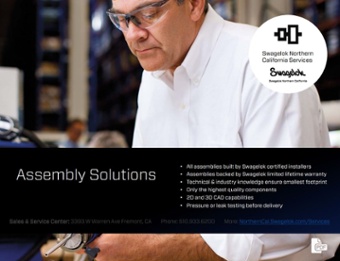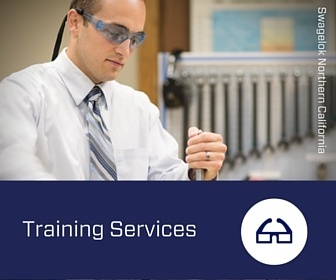Share this
Swagelok Valves for Instrumentation and Process Applications and More
by Jeff Hopkins on 5/4/17 8:00 AM
We have what you need for flow control, process protection, or just on-and-off
The starting point for valve selection is a basic question: What do I want the valve to do? Is it simply an on-off function, or do you need to control the flow? Do you need to control a thick fluid, a thin fluid or a gas? Do you need to make sure the fluid goes in only one direction?
Whatever you need, it takes only a click to reach all of Swagelok's valve catalogs and the Swagelok Valve Sizing Technical Bulletin.
On-off
For simple on-off control, the main choices are ball, plug, diaphragm, and bellows valves.
Ball valves, perhaps the most common of all valve types, can turn the flow on and off with just a quarter-turn of the handle. Swagelok's 60 series ball valves are designed for reliability and low maintenance. If you need to shut off high pressure and open it again, you might want the extra internal support of a trunion ball valve. Our specialty lines include our AFS ball valves for alternative fuel service.
Swagelok electric actuators can be used to control the position of many Swagelok ball valves, and we also have rack and pinion pneumatic actuators, solenoid valves, and limit switches
We have diaphragm valves for general, high-purity, and sanitary service. The LD Series is designed for shutoff, bulk-gas distribution, and isolation service. Our DP Series is suitable for ultrahigh-purity applications, and they now come with replaceable seats in our DPX Series. If you are looking for packless, all-metal containment, that's our DL Series and DS Series.
The semiconductor industry relies on our atomic layer deposition (ALD) diaphragm valves, with their ultrahigh cycle life with high-speed actuation. The valve opens to let a fine dose of reactive gas to sit briefly on the surface of the silicon wafer, then purge it, properly preparing the wafer to be etched. By "briefly," we're talking about only a few milliseconds. Swagelok was first to market with ALD valves more than a decade ago, and other manufacturers are still trying to catch up.
We also have the DRP Series of ultrahigh-purity fluoropolymer diaphragm valves, the DR Series of radial diaphragm valves, and the DF series of high-flow, springless diaphragm valves.
Our basic bellows valve is the B Series. Our BM Series of bellows-sealed metering valves features a micrometer handle for precise, repeatable flow settings. There are still other series of bellows valves for when you need a compact size, or a secondary containment system above the bellows, packless valves with an all-metal seal, and three-valve manifolds.
Flow control
Sometimes you need the flow to be somewhere between fully on and fully off. For that function, a needle valve is a great option. Some applications require a valve that ensures flow in only one direction. That's the time for a check valve. In most designs, the upstream fluid force cracks open a poppet, allowing flow. When there's an increase in the downstream back-pressure force, the poppet is forced back into its seat, preventing reverse flow. We have models with adjustable and fixed cracking pressures.
Still more options
For overpressure protection, the R Series proportional relief valve can be set a pressures from 10 to 6000 psig (0.68 to 413 bar). To stop uncontrolled release of system media if a downstream line ruptures, look into our XS Series of industrial excess flow valves.
There are more options than we have room to describe here, but our catalogs will give you the details on bleed valves and purge valves, metering valves, process interface valves and manifolds.
Sizing
Swagelok's Valve Sizing Technical Bulletin is an excellent tool showing how flow can be estimated well enough to select a valve size—easily, and without complicated calculations.
Additional Resources
Share this
- Archive (465)
- Assembly Services (207)
- About (100)
- Seal Support Systems (96)
- Best Practices (88)
- Training Services (74)
- Fittings (51)
- Semiconductor Applications (49)
- Hoses and Flexible Tubing (47)
- Regulators (44)
- Tubing (42)
- Grab Sampling Systems (32)
- Sampling Systems (32)
- Gas Systems (30)
- Services (30)
- Downloads (29)
- Valves (24)
- Application Support (18)
- Orbital Welding (17)
- Case Studies (13)
- Steam Systems (13)
- Frequently Asked Questions (12)
- Tools (12)
- Measurement Devices (7)
- Subsystems (6)
- Thermal Management (6)
- September 2023 (1)
- August 2023 (2)
- June 2023 (1)
- March 2023 (3)
- February 2023 (3)
- January 2023 (4)
- December 2022 (4)
- November 2022 (4)
- October 2022 (4)
- September 2022 (1)
- August 2022 (3)
- July 2022 (2)
- June 2022 (4)
- May 2022 (1)
- April 2022 (2)
- March 2022 (1)
- February 2022 (2)
- January 2022 (3)
- December 2021 (1)
- November 2021 (6)
- October 2021 (6)
- September 2021 (8)
- August 2021 (4)
- July 2021 (3)
- June 2021 (6)
- May 2021 (6)
- April 2021 (7)
- March 2021 (5)
- February 2021 (4)
- January 2021 (6)
- December 2020 (5)
- November 2020 (6)
- October 2020 (6)
- September 2020 (8)
- August 2020 (7)
- July 2020 (8)
- June 2020 (8)
- May 2020 (6)
- April 2020 (9)
- March 2020 (7)
- February 2020 (10)
- January 2020 (21)
- December 2019 (23)
- November 2019 (21)
- October 2019 (22)
- September 2019 (21)
- August 2019 (22)
- July 2019 (23)
- June 2019 (20)
- May 2019 (23)
- April 2019 (22)
- March 2019 (21)
- February 2019 (20)
- January 2019 (21)
- December 2018 (14)
- November 2018 (19)
- October 2018 (23)
- September 2018 (17)
- August 2018 (29)
- July 2018 (11)
- June 2018 (6)
- May 2018 (5)
- April 2018 (4)
- March 2018 (5)
- February 2018 (3)
- January 2018 (3)
- December 2017 (2)
- November 2017 (4)
- October 2017 (3)
- September 2017 (2)
- August 2017 (6)
- July 2017 (4)
- June 2017 (4)
- May 2017 (4)
- April 2017 (3)
- March 2017 (4)
- February 2017 (3)
- January 2017 (3)
- December 2016 (3)
- November 2016 (3)
- October 2016 (3)
- September 2016 (5)
- August 2016 (5)
- July 2016 (4)
- June 2016 (5)
- May 2016 (3)
- April 2016 (4)
- March 2016 (5)
- February 2016 (11)
- January 2016 (1)
- December 2015 (3)
- November 2015 (4)
- October 2015 (3)
- September 2015 (4)
- August 2015 (4)
- July 2015 (8)
- June 2015 (5)
- May 2015 (3)
- April 2015 (4)
- March 2015 (4)
- February 2015 (3)
- January 2015 (4)
- December 2014 (2)
- November 2014 (3)
- October 2014 (4)
- September 2014 (4)
- August 2014 (4)
- July 2014 (5)
- June 2014 (4)
- May 2014 (4)
- April 2014 (5)
- March 2014 (4)
- February 2014 (3)
- January 2014 (4)
- December 2013 (5)
- November 2013 (3)
- October 2013 (4)
- September 2013 (3)
- August 2013 (5)
- July 2013 (5)
- June 2013 (5)
- May 2013 (3)
- April 2013 (6)
- March 2013 (4)
- February 2013 (4)
- January 2013 (8)
- December 2012 (4)
- November 2012 (6)
- October 2012 (6)
- September 2012 (4)
- August 2012 (4)
- July 2012 (4)
- June 2012 (4)

.webp?width=210&height=70&name=StickyLogo%20(5).webp)


